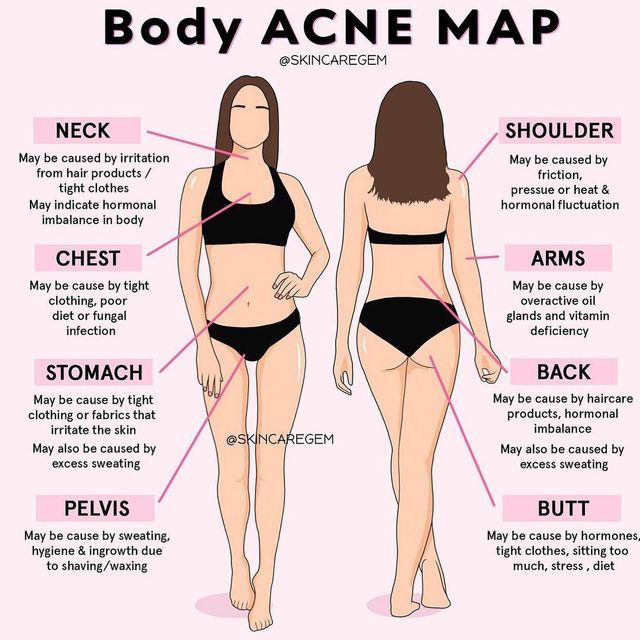Don’t you think acne is a very common skin disorder that affects millions of people worldwide? Although face acne receives a lot of attention, the importance of body acne should be considered. Body acne might reveal vital information about our general health.
Body acne has its own “acne map” that might reveal potential underlying health issues, similar to how facial acne is examined using a facial map. Understanding this map enables us to take proactive measures toward a healthier lifestyle and enhanced well-being, in addition to decoding the information our skin delivers.
In this article, we’ll explore what body acne might be trying to say about our interior health as we travel worldwide. So let’s move ahead and better understand acne map body.
The Acne Map Body: A Deeper Understanding of Body Acne

Like the concept of “face mapping,” which links various facial zones to particular internal imbalances or organ functions, the body can be divided into sections corresponding to likely acne-causing locations. Please allow us to navigate the body’s map of acne:
1. Back Acne (Bacne)
Sweat, oil, and friction are usually implicated as causes of this type of acne. It might be related to restrictive clothing, excessive sweating, and poor hygiene habits. However, if back acne persists and worsens, it may provide information about hormone imbalances, particularly in women.
2. Shoulder Acne
Shoulder acne is commonly related to poor hygiene habits because sweat, oil, and germs tend to collect in this area. Carrying backpacks or shoulder bags that trap sweat and grime against the skin could also result in shoulder acne. It could also be a sign of hormonal changes or circulatory abnormalities.
3. Chest Acne
The respiratory and digestive systems are closely entwined with the chest region. Acne on the chest could indicate that the body is sensitive to certain foods, allergies, or irritants. It might also imply that the digestive system isn’t functioning properly.
4. Butt Acne
Friction and too much moisture are the main causes of this condition. This situation may be brought on by extended durations of sitting, constructive clothing, and heavy perspiration. However acne may occasionally indicate hormonal changes or folliculitis, an infection of the hair follicles.
5. Arms Acne
Acne on the arms may indicate circulatory issues, blood sugar issues, or even an overabundance of keratosis pilaris, also known as chicken skin. Acne can result from poor circulation, preventing nutrients from reaching the skin efficiently.
Why is It Important to Understand the Acne Map Body?

Understanding the Acne Map Body is important because it affects more than just appearance; it is crucial to comprehend body acne. Instead, it shows potential internal health problems, providing insightful information about the body’s condition.
Here are a few strong arguments for why it’s important to understand acne map body:
1. Early Health Issue Detection
Body acne frequently acts as an early symptom of underlying health issues. Cystic or persistent acne, for example, can be related to hormone imbalances, intestinal problems, or metabolic abnormalities. Early detection of these symptoms can encourage people to seek medical care and treat these underlying health issues before they worsen.
2. Tailored Treatment Methods
Individuals can choose tailored treatment methods by understanding body acne’s precise patterns and locations. Instead of using a one size fits all approach, people can address the underlying reasons for their acne, which will result in more effective and efficient treatment outcomes.
3. Holistic Health Assessment
When examining body acne, it is impotent to consider the causes and the look of the skin. People are urged to evaluate their lifestyle choices, diet, personal hygiene routines, and stress levels as part of this holistic approach. The health and well-being of an individual can be generally improved by addressing these aspects.
4. Prevention and Management
People more aware of body acne can take prevention steps and employ efficient management techniques. For instance, if diet is a factor in body acne, people can make educated decisions regarding their dietary intake. If poor hygiene habits cause it, changing daily routines can lessen its incidence.
5. Physiological Well Being
Acne, whether it affects the face or the body, can significantly lower a person’s self-esteem and negatively affect their psychological well-being. Indivisible can take action to manage and treat their disease, increasing their self-confidence and mental health by being aware of the variables causing body acne.
6. Comprehensive Skin Care
Treating body acne requires a multifaceted strategy beyond merely addressing the signs and symptoms. Understanding the underlying causes enables people to develop a thorough skincare routine that caters to their needs and promotes long-term skin health.
7. Recognizing Triggers
Acknowledging the link between body acne and different triggers, such as particular foods, materials, or environmental variables, enables people to make educated decisions. They can reduce acne outbreaks’ likelihood by recognizing and avoiding these causes.
8. Improvement of Overall Well Being
People frequently choose healthier lifestyles to achieve clear, healthy skin. It can entail using stress reduction tactics, a healthy diet, and steppers exercise, all of which improve general well-being.
9. Signs of Hormonal Abnormalities
Body acne in particular regions, like the back or jawline, might indicate hormonal abnormalities. When people become aware of these trends, they may decide to get tested medically for hormone imbalances that could be harming their general health.
10. Personally Empowerment
Acknowledging one’s body acne gives one a sense of control over one’s health, so people are inspired to actively manage their skin conditions and make wise decisions to enhance their quality of life.
In essence, body acne provides a window into our body’s inner workings and is more than just an aesthetic problem. People can strive for healthy skin and a healthier body by understanding its messages and acting appropriately.
Decoding the Messages Encoded in Acne Map Body

While the acne map body provides a broad overview of possible body acne causes, it is crucial to remember that individual characteristics and genetic predisposition also significantly influence it.
Here’s how to interpret the possible messages concealed behind body acne:
1. Hormonal Imbalances
Hormones greatly influence acne formation. Body acne that appears suddenly or consistently in one area may indicate hormone imbalances. Consulting a healthcare expert is advised to identify and resolve these problems in such cases.
2. Attire and Hygiene
Poor hygiene habits, like skipping a post-workout shower or dressing up in filthy clothes, can result in clogged pores and acne. Choosing constructive or unbreathable textiles can also trap sweat and oil, aggravating existing acne.
3. Dietary Influences
Our food choices can be reflected in our skin as a mirror. Acne may develop due to consuming too many processed foods, dairy products, sweet treats, or substances to which one may be allergic. Consider eating a nutritious, well-balanced diet while closely examining how the skin reacts.
4. Stress and Lifestyle
Prolonged stress can cause hormonal changes that act as acne-causing catalysts. Additionally, an unhealthy lifestyle marked by insufficient sleep, excessive alcohol intake, and tobacco use can hurt the skin’s health.
5. Stress and Lifestyle
Prolonged stress can cause hormonal changes that act as acne-causing catalysts. Additionally, an unhealthy lifestyle marked by insufficient sleep, excessive alcohol intake, and tobacco use can negatively impact the skin’s health.
Prevention Action: Preventing and Reducing Acne Map Body
Understanding the messages that body acne could be trying to tell us is the first step in resolving underlying problems.
Here are some practical steps one can take to prevent the beginning of body acne and battle it:
- Maintaining Optimal Hygiene: Showering is essential, especially after exercising or other activities that cause considerable sweat. Use gentle cleansers that remove dirt and grime without removing the skin’s natural hydration.
- The Choice of Breathable Clothes: Choose clothing made of airy, loose-fitting materials that promote skin respiration. Avoid wearing tight clothing that could trap sweat and microorganisms.
- Adequate Hydration: Drinking plenty of water helps to keep the skin hydrated and boosts skin vitality in general.
- Healthy Eating Habits: Adopt a diet high in fresh produce, lean meats, and whole grains. Reducing your intake may be helpful if processed meals, sweet treats, and dairy products cause acne.
- Efficient Skincare Routine: Use non-comedogenic skin care products and Liquid Salicylic Acid Exfoliant frequently to prevent the buildup of dead skin cells in pores. A wise course of action is to get tailored advice from a dermatologist.
- Guidance From Medical Professionals: It is wise to speak with a dermatologist or other healthcare professionals if body acne persists, worsens, or is accompanied by other symptoms. They can help identify underlying issues and suggest appropriate therapy trajectories.
Conclusion
Finally, the importance of understanding the acne map body extends far beyond the field of skincare. It can reveal information about our interior health that could otherwise be obstructed as a diagnostic tool.
We may take proactive measures that lead to smoother skin and a better life by understanding the messages that body acne is trying to tell us and heeding its cautiousness.
Body acne motivates us to adopt a holistic wellness strategy that considers aspects of our food, hygiene, way of life, and stress reduction. Taking proactive steps to treat the underlying causes of body acne may improve our physical, mental, and emotional well-being.
We set out toward a healthier and more satisfying existence as we go toward having better skin. Keep in mind that your body acne map is a compass that directs you toward increased overall well-being, not just a guide to beautiful skin.
Frequently Asked Questions
Can Body Acne Be a Sign of Underlying Medical Conditions?
Absolutely! Body acne frequently reflects hormone dysregulation, food sensitivity, or intestinal issues. People can proactively address their health concerns by recognizing these underlying factors through the distribution and patterns of their body acne.
How Can I Tell the Difference Between Typical Acne and a Breakout That Might Be Related to My Health?
Sweat, oil, and germs are frequent causes of regular acne. However, seeking the advice of a dermatologist or healthcare expert can be worthwhile if you experience sudden and recurring breakouts in particular parts of your body. They can assist in figuring out whether there are underlying health problems causing acne.
How Does Stress Impact Acne on The Body?
Stress can cause hormonal changes that support the emergence of acne. Cortisol and other stress hormones can increase skin inflammation and oil production, both of which are associated with the development of acne. Including stress reduction practices like meditation and exercise in your regimen can lessen the negative effects of stress on your skin.
Can Over-the-counter Medications Be Used to Treat Body Acne?
Over-the-counter medications with components like salicylic acid or benzoyl peroxide may work well for mild cases of body acne. However, it is advised to seek professional advice if your body’s acne is severe or persistent. If necessary, a dermatologist might recommend stronger medications and offer individualized advice.
How Does Genetics Affect Acne in The Body?
Acne susceptibility in an individual might be influenced by genetics. You can be more likely to get acne if your family has a history of having it. However, lifestyle, diet, and environmental factors also have a big impact, so genetics isn’t the only element that matters.





